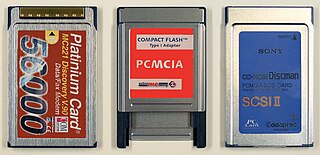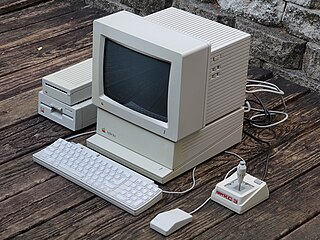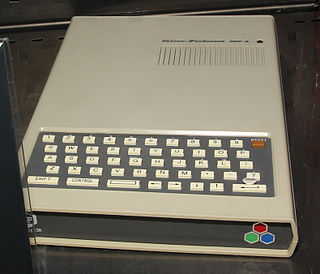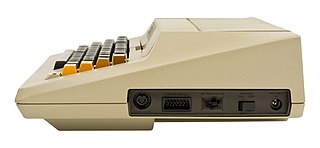
The Tandy 1000 is the first in a line of IBM PC compatible home computer systems produced by the Tandy Corporation for sale in its Radio Shack and Radio Shack Computer Center chains of stores. Introduced in 1984, the product line was aimed at providing affordable but capable systems for home computing or education, with some of its Tandy specific features like graphics, sound and joystick port making it more appealing for home use.

PC Card is a parallel peripheral interface for laptop computers and PDAs. The Personal Computer Memory Card International Association (PCMCIA) originally introduced the 16-bit ISA-based PCMCIA Card in 1990, but renamed it to PC Card in March 1995 to avoid confusion with the name of the organization. The CardBus PC Card was introduced as a 32-bit version of the original PC Card, based on the PCI specification. The card slots are backward compatible for the original 16-bit card, older slots are not forward compatible with newer cards.

The Amiga 600, also known as the A600, is a home computer introduced in March 1992. It is the final Amiga model based on the Motorola 68000 and the 1990 Amiga Enhanced Chip Set. A redesign of the Amiga 500 Plus, it adds the option of an internal hard disk drive and a PCMCIA port. Lacking a numeric keypad, the A600 is only slightly larger than an IBM PC keyboard, weighing approximately 6 pounds (2.72kg). It shipped with AmigaOS 2.0, which was considered more user-friendly than earlier versions of the operating system.

In computing, an expansion card is a printed circuit board that can be inserted into an electrical connector, or expansion slot on a computer's motherboard to add functionality to a computer system. Sometimes the design of the computer's case and motherboard involves placing most of these slots onto a separate, removable card. Typically such cards are referred to as a riser card in part because they project upward from the board and allow expansion cards to be placed above and parallel to the motherboard.

The Apple IIe Card is a compatibility card, which through hardware and software emulation, allows certain Macintosh computers to run software designed for the Apple II series of computers. Released in March 1991 for use with the LC family, Apple targeted the card at its widely dominated educational market to ease the transition from Apple II-based classrooms, with thousands of entrenched educational software titles, to Macintosh-based classrooms.

The Amiga 3000, or A3000, is a personal computer released by Commodore in June 1990. It is the successor to the Amiga 2000 and its upgraded model Amiga 2500 with more processing speed, improved graphics, and a new revision of the operating system.

The Apple IIGS is a 16-bit personal computer produced by Apple Computer. It is the fifth and most powerful of the Apple II family. It is compatible with earlier Apple II models but has a Macintosh look and feel, and resolution and color similar to the Amiga and Atari ST. The "GS" in the name stands for "Graphics and Sound", referring to its enhanced multimedia hardware, especially its state-of-the-art audio.

The Apple IIc is a personal computer introduced by Apple Inc. shortly after the launch of the original Macintosh in 1984. It is essentially a compact and portable version of the Apple IIe. The IIc has a built-in floppy disk drive and a keyboard, and was often sold with its matching monitor. The c in the name stands for compact, referring to the fact it is a complete Apple II setup in a smaller notebook-sized housing. It is compatible with a wide range of Apple II software and peripherals.

The Commodore Plus/4 is a home computer released by Commodore International in 1984. The "Plus/4" name refers to the four-application ROM-resident office suite ; it was billed as "the productivity computer with software built in".
The 6551Asynchronous Communications Interface Adapter (ACIA) is an integrated circuit made by MOS Technology. It served as a companion UART chip for the widely popular 6502 microprocessor. Intended to implement RS-232, its specifications called for a maximum speed of 19,200 bits per second with its onboard baud-rate generator, or 125 kbit/s using an external 16x clock. The 6551 was used in several computers of the 1970s and 1980s, including the Commodore PET and Plus/4. It was also used by Apple Computer on the Apple II Super Serial Card, and by Radio Shack on the Deluxe RS-232 Program Pak for their TRS-80 Color Computer.

Microprofessor II is an Apple II clone introduced in 1982 by Multitech. It is Multitech's second branded computer product and also one of the earliest Apple II clones. It does not look like most other computers. The case of the MPF II was a slab with a small chiclet keyboard on its lower part.

Applied Engineering, headquartered in Carrollton, Texas, was a leading third-party hardware vendor for Apple II computers from the early 1980s until the mid-1990s.

The Commodore 64 home computer used various external peripherals. Due to the backwards compatibility of the Commodore 128, most peripherals would also work on that system. There is also some compatibility with the VIC-20 and Commodore PET.

The Apple IIc Plus is the sixth and final model in the Apple II series of personal computers, produced by Apple Computer. The "Plus" in the name was a reference to the additional features it offered over the original portable Apple IIc, such as greater storage capacity, increased processing speed, and a general standardization of the system components. In a notable change of direction, the Apple IIc Plus, for the most part, did not introduce new technology or any further evolutionary contributions to the Apple II series, instead merely integrating existing peripherals into the original Apple IIc design. The development of the 8-bit machine was criticized by quarters more interested in the significantly more advanced 16-bit Apple IIGS.

The CMOS W65C51 Asynchronous Communications Interface Adapter (ACIA) provides an easily implemented, program controlled interface between microprocessor based systems and serial communication data sets and modems. It is produced by Western Design Center (WDC) and is a drop-in replacement for the MOS Technology 6551.

The Macintosh Quadra 605 is a personal computer designed, manufactured, and sold by Apple Computer from October 1993 to July 1996. The model names reflect a decision made at Apple in 1993 to follow an emerging industry trend of naming product families for their target customers – Quadra for business, LC for education, and Performa for home. Accordingly, the Performa 475 and 476 was sold in department stores and electronics stores such as Circuit City, whereas the Quadra was purchased through an authorized Apple reseller.
The Apple II line of computers supported a number of Apple II peripheral cards. In an era before plug and play USB or Bluetooth connections, these were expansion cards that plugged into slots on the motherboard. They added to and extended the functionality of the base motherboard when paired with specialized software that enabled the computer to read the input/output of the devices on the other side of the cable or to take advantage of chips on the board - as was the case with memory expansion cards.
Apple II system clocks, also known as real-time clocks, were devices in the early years of microcomputing. A clock/calendar did not become standard in the Apple II line of computers until 1986 with the introduction of the Apple IIGS. Although many productivity programs as well as the ProDOS operating system implemented time and date functions, users would have to manually enter this information every time they turned the computer on. Power users often had their Apple II's peripheral slots completely filled with expansion cards, so third party vendors came up with alternative approaches with products like the Serial Pro and No-Slot Clock.

The Apple Communication Slot, or Comm Slot, is an internal expansion data interface (slot) found in Apple Macintosh computers from the early to mid-1990s. It was designed as an inexpensive way to add communication expansion cards like network adapters or modems to Macs and Power Macs.

The Serial Input/Output system, universally known as SIO, was a proprietary peripheral bus and related software protocol stacks used on the Atari 8-bit computers to provide most input/output duties for those computers. Unlike most I/O systems of the era, such as RS-232, SIO included a lightweight protocol that allowed multiple devices to be attached to a single daisy-chained port that supported dozens of devices. It also supported plug-and-play operations. SIO's designer, Joe Decuir, credits his work on the system as the basis of USB.

















